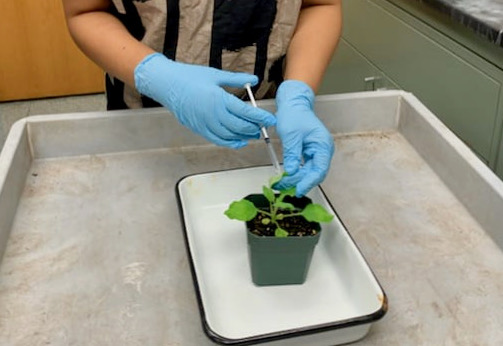RIPE team develops toolkit for synthetic biology

BATON ROUGE, LA. — A team from Louisiana State University (LSU) has developed a number of synthetic biology tools for plant geneticists to use to drive the expression of genes. Their work will allow researchers to test their ideas before implementing them in long-term experiments, saving time and money.
“Our work could be a proof of concept before you get to the point of stable transgenic lines,” said Debarati Basu, a postdoctoral researcher at LSU, who led this work for a research project called the Realizing Increased Photosynthetic Efficiency (RIPE). “Transgenic line experiments are long term and may take six months or more. You don’t want to get to that point and find out that it didn’t work because you were using the wrong gene promoter.”
RIPE, which is led by the University of Illinois, is engineering crops to be more productive by improving photosynthesis, the natural process all plants use to convert sunlight into energy and yields. RIPE is supported by the Bill & Melinda Gates Foundation, Foundation for Food & Agriculture Research, and U.K. Foreign, Commonwealth & Development Office.
In a recent study, published in Frontiers in Plant Science, Basu and her advisor Paul South took pieces of DNA that are already used in photorespiration gene expression and created synthetic fragments with combinations of those pieces to drive the expression of transgenic DNA parts that could modify photorespiration.
“The paper is all about giving scientists doing transgenic research a toolkit because we often use the same promoters to express a bunch of genes,” said Basu. “If you work with the wrong plants you may get gene silencing, or you may need multiple generations, so the best idea would be to test the promoters you are using in a transient assay to see how they work.”
Besides trying to build new DNA pieces that can be used for expressing multiple genes simultaneously in plants, Basu has also looked at generating synthetic promoters using DNA fragments from native promoters. To avoid unintended effects associated with strong promoters, including the silencing of the transgene, the South Lab has generated synthetic promoters utilizing native DNA fragments from the promoters of key photorespiratory genes. In this study, they tested the effect of a reporter gene under such synthetic promoters in response to optimal conditions as well as various stress conditions, like elevated temperature, high light intensity, and low CO2.
These findings not only enrich the existing repertoire of DNA elements necessary for generating transgenic plants, but also shed light on how photorespiratory genes may be regulated in optimal and stress conditions.
“We’re making these DNA parts to be in our toolbox and also stress testing them,” said Paul South, assistant professor of plant physiology at LSU. “People have made DNA parts to go into synthetic designs before, but now we’re testing them in different stress conditions.”
South went on to explain that stress testing the DNA parts for synthetic biology is as essential as stress testing parts for a car. Nuts and bolts being used in a car are stress-tested for vibration, temperature changes, pressure, and breakage so that they are ensured to perform their best when they need to. In the same manner, plants and the synthetic DNA parts that get put in them need to be tested for temperature to simulate field conditions.
Now that the DNA parts have been stress tested, Basu and South hope to be able to provide them as a toolkit for other researchers to use.
RIPE is led by the University of Illinois in partnership with The Australian National University, Chinese Academy of Sciences, Commonwealth Scientific and Industrial Research Organisation, Lancaster University, Louisiana State University, University of California, Berkeley, University of Cambridge, University of Essex, and U.S. Department of Agriculture, Agricultural Research Service.
By: Allie Arp || RIPE Communications Manager
